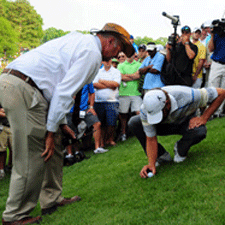In last week’s Wells Fargo Championship at Quail Hollow Golf Course Lucas Glover found himself on a slippery slope left of the 18th fairway needing a par to preserve his chance for a win. After driving his ball well left Glover’s ball came to rest in and amongst the fans watching on the hillside. Since Glover’s ball had come to rest on a spectator, he was allowed to drop the ball directly on the ground below where the ball came to rest. Each time Glover dropped the ball, the ball rolled more than two club lengths so after his second drop Glover was allowed to place the ball on the spot where it struck the ground on the re-drop. Once Glover removed his hand and the ball remained at rest for a few seconds, the ball was back in play.
What happened next is a bit unusual, but it serves to underscore an important principle in the Rules of Golf. While Glover surveyed his second shot the ball, which had been at rest for several seconds, began to roll further down the steep hillside. Since Glover had not addressed the ball he was not penalized and was required to play the ball from its new position. In this particular case the ball moved to a more favorable position giving Glover a better angle on his approach to the green.
While this incident looked a bit odd, it does make sense when you consider this principle: When a ball is in play it is always exposed and subject to “the elements.” Once Glover had succeeded in getting his ball back in play it’s a bit like a movie director calling out “Action!” At that point the ball, while at rest, is exposed to the wind, rain and gravity. What makes the situation look strange is the fact that Glover lifted, dropped and then placed his ball prior to its rolling down the slope. If Glover’s ball had come to rest on that same slope, but not in a position where a drop was required and his ball rolled further down the slope before Glover had addressed it, the ruling would be the same. In that case, the ball was in play that whole time and simply took a long time to settle into its ultimate resting place.
In Glover’s case the “elements” assisted him by moving the ball to a more favorable location. Those of us who play golf know that the golfing gods are not always so kind. A few years ago on the LPGA Tour a player hit her ball over a water hazard onto the green. After lifting and cleaning the ball (as is permitted under Rule 16 ““ the putting green rule) the player replaced the ball on the green. At that point our “director” has once again called “Action!” and that ball is once again subject to the elements. In this case the ball began rolling, gathered speed and rolled into the water hazard. Since the player, like Glover, had not addressed the ball, the ball must be played as it lies. Sadly for this player that meant that the ball was in the water hazard and the player was now required to go back and play their next shot under a penalty of one stroke under the water hazard rule. Again, what makes this seem odd is the fact that the player had their ball in their hand at one point. But despite that fact, once the player put the ball back on the green it is now in play and subject to the elements. The result is no different than if the player’s ball came to rest on the green for a few seconds and before the player reached the ball, the ball began rolling into the water hazard. In both cases the ball simply took its sweet time getting to its finally resting place””in this case the watery grave of the water.
So remember whenever you drop or place a ball and the ball remains at rest for a few seconds, it’s in play! Lift, drop, “Action!”


